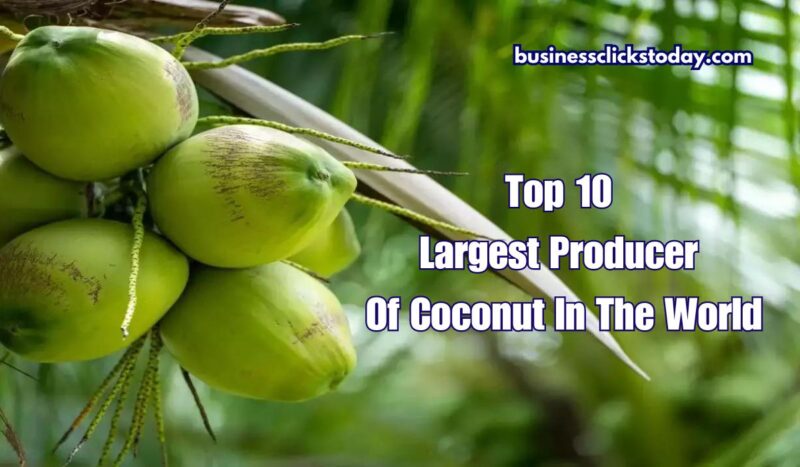Coconut, often hailed as the “tree of life,” has a profound global impact, serving diverse purposes from culinary applications and skincare to being a critical ingredient in various industrial products. As the world recognizes the versatility of this tropical crop, the competition among countries to be the largest producer of coconut continues to intensify. In 2024, the global landscape of coconut production is dominated by several key players, each contributing significantly to the world’s coconut trade. This article delves into the top 10 largest producers of coconut and their influence on the global market.
Top 10 Largest Producer Of Coconut In The World

1. Indonesia – 17.13 Million Metric Tons
Indonesia stands as the largest producer of coconut in the world, with an impressive output of 17.13 million metric tons. The country’s tropical climate, abundant rainfall, and extensive coconut plantations create the perfect environment for coconut cultivation. The dedication of Indonesian farmers and the country’s robust agricultural practices contribute to its top position in global coconut production. The consistent quality and high yield from Indonesia’s vast coconut fields underscore its pivotal role in the global coconut market.
Indonesia’s exceptional coconut production is supported by its ideal growing conditions and experienced growers. The nation’s strategic agricultural focus and commitment to sustainability have reinforced its status as the world’s leading coconut producer and a major supplier of coconut-based products.
2. Philippines – 14.77 Million Metric Tons
The Philippines ranks second in coconut production globally, generating 14.77 million metric tons. Coconut cultivation is deeply embedded in Filipino culture and economy, with extensive farms scattered across the country. The lush coconut palms of the Philippines are a symbol of its agricultural prowess, showcasing the country’s significant contribution to the global coconut trade.
Coconuts are integral to Philippine culture and cuisine, highlighting their economic and cultural importance. The Philippines’ vast coconut production capacity emphasizes its role as a major player in the global coconut industry.
3. India – 14.68 Million Metric Tons
India holds the third position in global coconut production, with an output of 14.68 million metric tons. The country’s diverse agro-climatic zones support the cultivation of various coconut varieties. From the coastal regions of Kerala to the arid areas of Tamil Nadu, coconuts are a staple crop across India.
Coconuts play a crucial role in Indian agriculture, cuisine, and culture. They are used in a multitude of ways, including in traditional dishes, religious ceremonies, and as a symbol of purity. The widespread cultivation and utilization of coconuts in India underline its importance in the global coconut market.
4. Sri Lanka – 2.46 Million Metric Tons
Sri Lanka, known for its Ceylon coconuts, produces 2.46 million metric tons, placing it fourth globally. Despite its smaller land area compared to other top producers, Sri Lanka excels in coconut agriculture through sustainable and high-quality practices. Ceylon coconuts from Sri Lanka are renowned for their flavor and quality, making the country a significant player in the global coconut trade.
The commitment to ethical and sustainable coconut farming in Sri Lanka has attracted global attention, reinforcing its position as a key supplier of premium coconut products.
5. Brazil – 2.33 Million Metric Tons
Brazil is the largest producer of coconuts in South America, with an output of 2.33 million metric tons. The country’s extensive coastline and tropical climate provide an ideal environment for coconut cultivation. Brazil’s diverse climatic conditions, from the northern region of Bahia to the beaches of Rio de Janeiro, contribute to its substantial coconut production.
Brazil’s ability to produce high-quality coconuts, supported by its favorable weather conditions, highlights its adaptability and importance in the global coconut market.
6. Vietnam – 1.68 Million Metric Tons
Vietnam ranks sixth in coconut production, with 1.68 million metric tons. The country’s agricultural heritage and favorable climate make it a significant contributor to the global coconut supply chain. Vietnam’s traditional farming methods and coconut-friendly climate contribute to its successful coconut production.
The combination of agricultural expertise and a conducive environment enables Vietnam to produce high-quality coconuts that meet both local and international standards.
7. Mexico – 1.29 Million Metric Tons
Mexico produces 1.29 million metric tons of coconuts, securing the seventh position globally. The country’s tropical regions, particularly Guerrero and Oaxaca, are ideal for coconut cultivation. Mexico’s strategic location and extensive coconut fields demonstrate its capacity to meet both local and international demand.
Mexico’s coconut industry not only supports local economies but also contributes significantly to the global coconut trade. The country’s ability to export coconuts and their derivatives emphasizes its role in the global market.
8. Papua New Guinea – 1.19 Million Metric Tons
Papua New Guinea produces 1.19 million metric tons of coconuts, making it the eighth-largest producer globally. The country’s unique landscapes and commitment to sustainable agriculture set it apart in the coconut industry. Papua New Guinea’s diverse growing conditions and emphasis on ethical farming practices contribute to its notable coconut production.
The country’s focus on sustainability and high-quality coconuts aligns with global trends toward eco-friendly agriculture, enhancing its reputation in the international coconut market.
9. Thailand – 0.81 Million Metric Tons
Thailand ranks ninth in coconut production, with an output of 0.81 million metric tons. Known for its vibrant culture and cuisine, Thailand’s coconut industry, though smaller in scale compared to others, is marked by efficiency and sustainability. The country’s dedication to producing high-quality coconuts and meeting global demands reflects its commitment to the industry.
Coconuts play a significant role in Thai food, culture, and religion, showcasing their importance beyond mere agricultural production.
10. Malaysia – 0.54 Million Metric Tons
Malaysia, with a production of 0.54 million metric tons, rounds out the top ten coconut producers globally. Despite its relatively modest output, Malaysia’s agricultural sector relies heavily on coconut cultivation. The country’s commitment to sustainable practices and quality production supports its position in the global coconut market.
Coconuts are integral to Malaysia’s culture and economy, with their importance extending beyond agriculture to influence daily life and traditions.
Conclusion
Coconuts hold a crucial place in the global landscape, impacting everything from culinary practices to skincare routines. In 2024, the largest producers of coconut in the world, including Indonesia, the Philippines, and India, highlight the geographical diversity and extensive cultivation of this essential tropical crop. As these nations continue to contribute significantly to the global coconut market, their efforts shape economic trends, support millions of livelihoods, and promote environmental sustainability. The role of the largest producer of coconut in the world underscores the crop’s importance and its far-reaching influence on various aspects of life and industry worldwide.
















